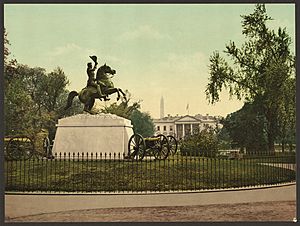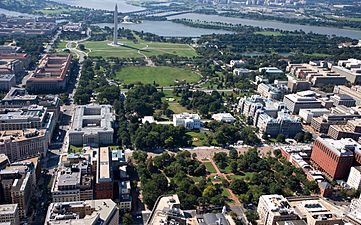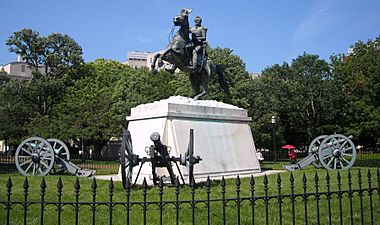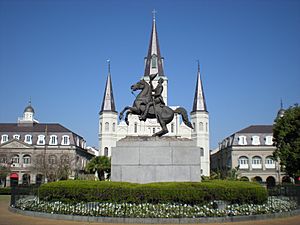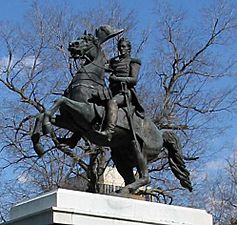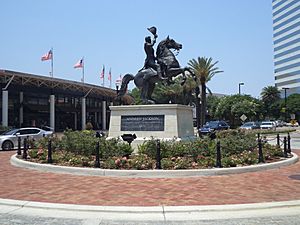Equestrian statue of Andrew Jackson (Washington, D.C.) facts for kids
Quick facts for kids Andrew Jackson |
|
|---|---|
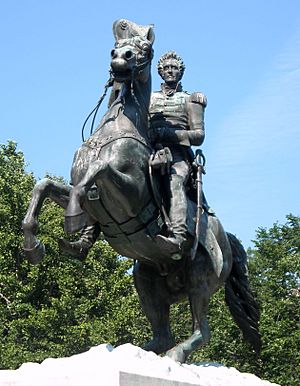 |
|
| Artist | Clark Mills |
| Year | 1852 |
| Type | Bronze |
| Dimensions | 2.4 m × 3.7 m (8 ft × 12 ft) |
| Location | Washington, D.C., United States |
| 38°53′58″N 77°02′12″W / 38.89952°N 77.03655°W | |
| Owner | National Park Service |
The Andrew Jackson statue is a large bronze sculpture. It shows Andrew Jackson riding a horse. The statue stands in the middle of Lafayette Square in Washington, D.C.. This park is just north of the White House.
The statue shows Jackson in his military uniform. He is raising his hat with one hand. With his other hand, he holds the horse's reins. The horse is rearing up on its back legs. The statue sits on a white marble base.
Contents
Who Was Andrew Jackson?
The statue honors Andrew Jackson. He was a famous general. He led American forces in the Battle of New Orleans in 1815. Later, he became the seventh president of the United States. He served as president from 1829 to 1837.
The idea for the statue came about in 1847. This was almost two years after Jackson passed away. A group called the Jackson Monument Committee ordered the statue.
Creating the Statue
The sculptor, Clark Mills, was chosen to create the statue. He had never met Andrew Jackson. He also had never made a statue of a person on a horse before. But his design won the competition.
Mills taught himself how to make large bronze statues. Jackson's horse at the Battle of New Orleans was named Duke. However, Mills used his own horse, Olympus, as a model. He even trained Olympus to stand on its back legs! Mills also borrowed Jackson's actual uniform to make the statue look real.
Mills built his own foundry to cast the statue. A foundry is a place where metal is melted and shaped. He made several attempts before finishing the final statue. It was made from ten pieces. Six pieces were for Jackson, and four for the horse. An enslaved apprentice named Phillip Reid helped Mills with the casting.
The statue was finished in 1852. It was the first equestrian (horse-riding) statue made in the United States. It was also the first bronze statue cast in the US. This statue was special because the horse rears up on two legs without extra support. Older statues often used the horse's tail as a third support. Tests in 1993 showed that the back legs have strong iron cores inside. This makes them strong enough to hold up the heavy statue.
About the Statue's Design
The statue is about one-third larger than a real person. It weighs around 15 tons. It stands on a tall, rectangular marble base. This base is in a circular grassy area with railings.
On the west side of the marble base, you can read "JACKSON." Below that, it says "OUR FEDERAL UNION / IT MUST BE PRESERVED." This quote was added in 1909. It comes from a famous speech Jackson gave. On the south side, it says "CLARK MILLS," honoring the sculptor.
Around the marble base are four cannons. These cannons were captured by Jackson from the Spanish in 1818. At first, the cannons rested on the grass. Later, they were placed on wooden stands.
Dedication and History
The statue was officially revealed on January 8, 1853. This date was special because it was the 38th anniversary of the Battle of New Orleans. Many people came to the dedication, including President Millard Fillmore. Cannons from the US Army fired a salute. People worried if the statue was stable. Clark Mills reportedly showed how strong it was by leaning against the horse's raised front legs. The statue did not move!
Over time, Lafayette Square changed. Other statues were added around Jackson's statue. These statues honor heroes from the American Revolutionary War. They include Lafayette, Rochambeau, Von Steuben, and Kościuszko.
In 2020, some people tried to pull down the statue during protests. They were not successful. After this, some people suggested adding plaques to the monument. These plaques would help explain Jackson's complex history.
Other Statues Like This One
Clark Mills made two other copies of this statue.
- One was placed in Jackson Square in New Orleans, Louisiana, in 1856.
- Another was placed on the Tennessee State Capitol grounds in Nashville, Tennessee, in 1880. Mills attended both of these dedications. The Nashville event was his last public appearance before he passed away in 1883.
A fourth copy of the statue was made in 1987. It stands in Jacksonville, Florida.
Images for kids


